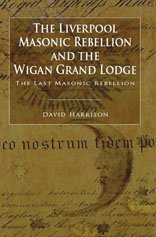En: Review: "The last Rebellion" from David Harrison
The Last Rebellion
Once again David Harrison takes us into the realm of social history in the industrial north of England in the early nineteenth century, this time concentrating on the great port of Liverpool, where we take a look at society in general and Freemasonry in particular and the aspirations of certain individuals to create a better life for themselves.
Liverpool in the early 1800s was a hive of activity - the slave trade was at its height and the industrial revolution was in full swing. The city was, as David Harrison says, almost a tale of two cities, with affluence on the one hand and poverty coupled with chronic disease on the other.
The time in which the story is set was also one of importance for Freemasons, as negotiations had been going on from the late 1790s between the Moderns’ Grand Lodge of Freemasons and the Grand Lodge of the Antients, culminating in the Union in 1813. This union was meant to bring together the rival Masonic factions under the United Grand Lodge of England, headed by the autocratic Duke of Sussex.
We are taken through a list of lodges and personalities before we occupy a balcony seat to watch the unfolding of ‘the last great Masonic rebellion’, with all its grievances and intrigue.
Michael Alexander Gage, a Liverpool tailor, became the leader of the rebels and it was he who was to gain notoriety throughout the Masonic world for his forthright address to HRH Prince Augustus Frederick, Duke of Sussex, the first Grand Master of the United Grand Lodge of England, which was not very well received at all by those who held power. Gage did not pull any punches and neither was he afraid to complain about the imposition of fees on provincial lodges for the building of Freemasons’ Hall in London.
Gage was not alone, for there were others, perhaps not as vociferous as he, but who nevertheless were at the forefront in sharing the grievances and discontent in the city lodges. The discontent was not just one way towards United Grand Lodge - there was also opposition in Liverpool to Gage and his rebellious colleagues, which led to a feud between the rebels on the one hand and supporters of the Duke of Sussex on the other. Such was this feud, that to describe it as a disagreement would be an understatement and the author gives us in detail some of the less attractive behaviour of Mason against Mason.
Wigan is some twenty-five miles from Liverpool and there was a great amount of trade between the two. Coal went to Liverpool to fuel the vast armada of ships plying the Atlantic and cotton was taken to Wigan to be made into fabric in the weaving mills of south Lancashire. It was to there that the rebellion spread, after the Wigan Masons became involved.
David Harrison concentrates in his book on the Liverpool aspect of the rebellion, whereas much of what has been written previously has tended to concentrate on the re-formation of the Antients’ Grand Lodge and the happenings in Wigan which led to it being known as the Grand Lodge in Wigan. He does the Masonic world a great favour by telling us what went on in Liverpool Freemasonry in some detail and gives us an insight into previously unpublished material including what can only be described as a remarkable Masonic document, the Magna Charta of Masonic Freedom. This document is given as an Appendix in the book and makes extremely interesting reading, giving the rebels’ view of the behaviour of United Grand Lodge.
David Harrison is to be congratulated for producing this book and giving us such an in-depth analysis of the last rebellion on such a scale in English Freemasonry.
It makes an excellent read.
Fred Lomax
Price: £9.99 Publisher: Arima Publishing ISBN: 9781845495619


